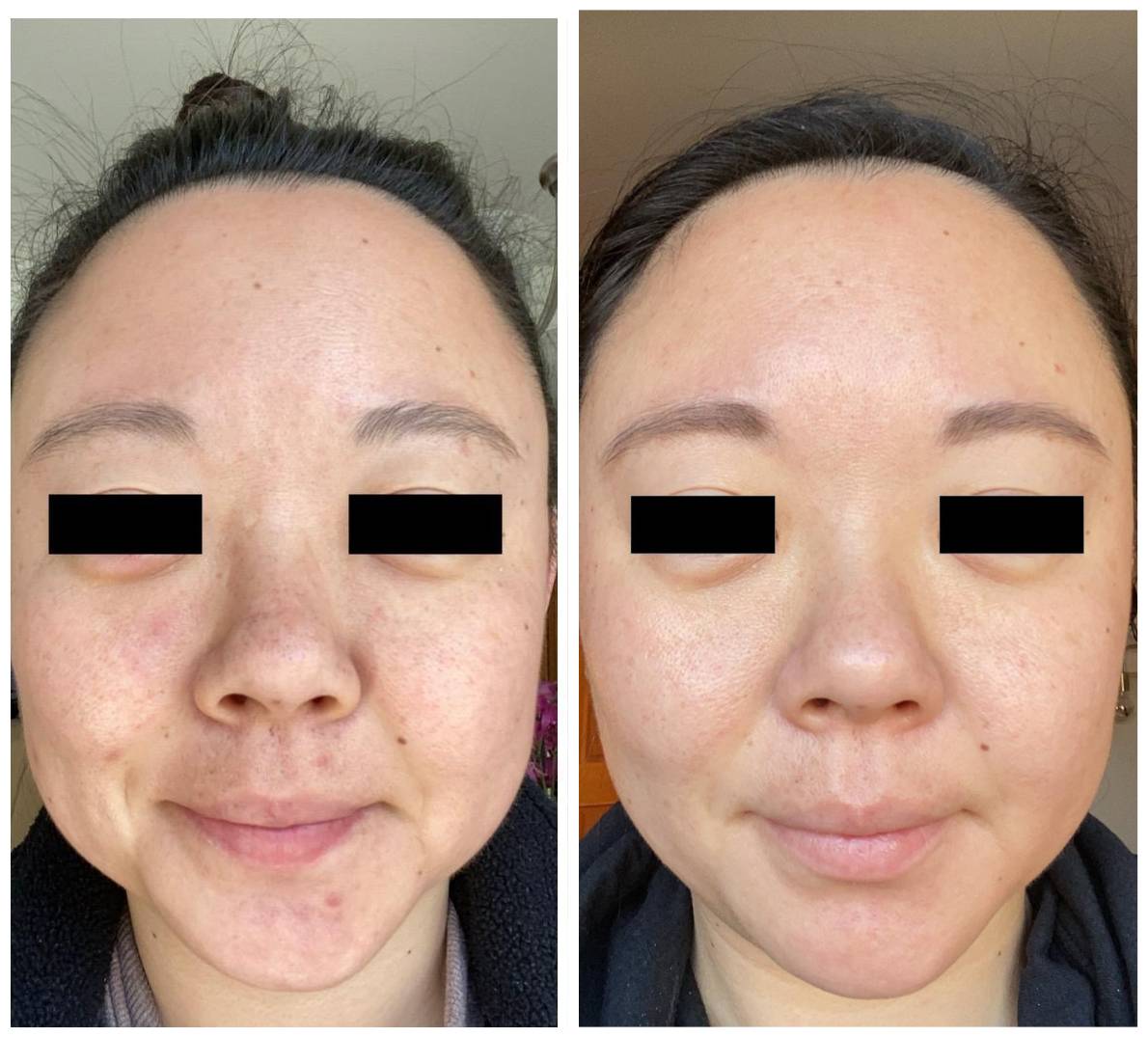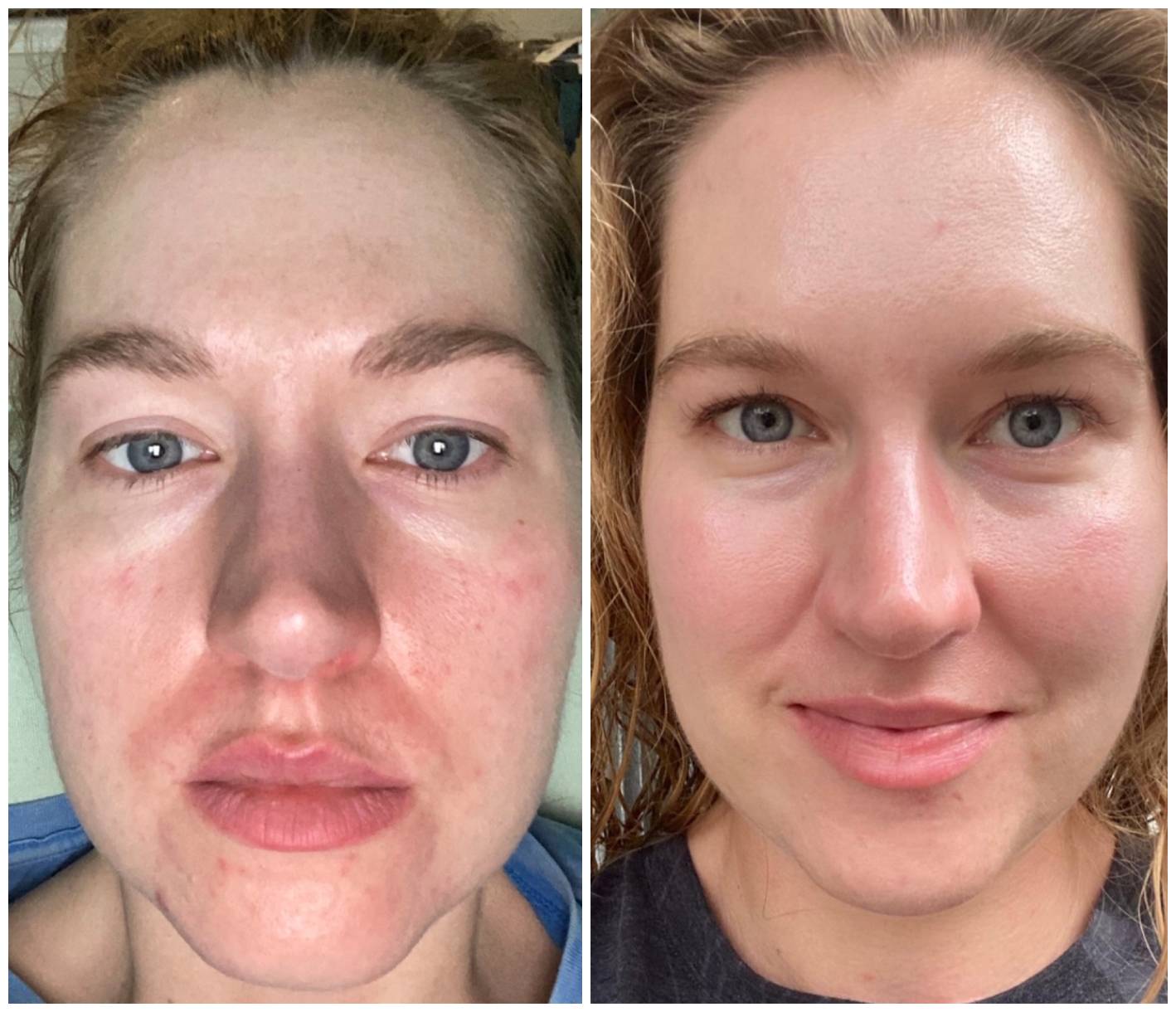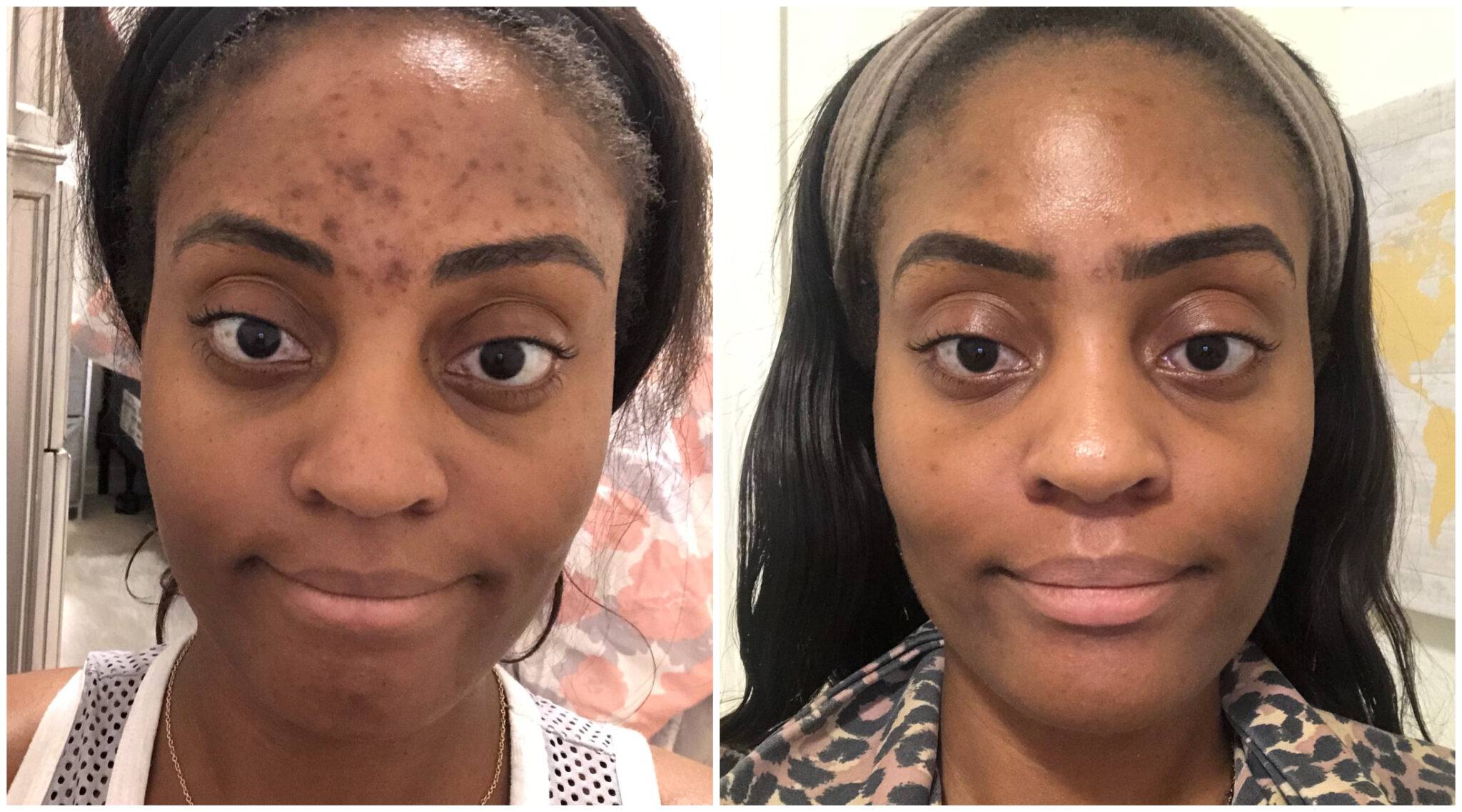Table of Contents
Tretinoin Before And After- Know What To Expect!
Tretinoin before and after pictures and results might have pushed you to give it a try. Most people are fascinated by the results shown by tretinoin on others’ skin and often try it without proper instructions or guidelines, while some do not even use a prescription.
Tretinoin is a special medication or gel used to treat severe acne and skin damaged by harmful sun rays. It cannot eliminate deep wrinkles but it does improve the appearance of fine lines, surface wrinkles, and dark spots thus giving you soft skin overall without spots.
Tretinoin is also called Retinoic acid. It is the generic term for synthetic vitamin A. You will find tretinoin sold under different generic names. Retin-A is one such brand that sells tretinoin and it should not be mixed with retinol.
Let’s take a closer look at tretinoin before and after results and find out if you should use it with a prescription or not.
What is Tretinoin?

Tretinoin is prescribed medicine in the form of a topical gel and is mainly used to treat fine wrinkles, sun-damaged skin, and acne. It might sound a bit counterintuitive, but it operates by irritating your skin. Tretinoin is capable of speeding the life cycle of cells. It advances the cells to replicate faster and deteriorate faster, thus allowing newer and healthier cells to take their place.
There are numerous brands which you will find tretinoin under, including the following:
- Altreno
- Atralin
- Refissa
- Rejuva
- Retin-A
- Stieva
- Avita
- Renova
- Tretin-X
Tretinoin is often used in the form of an ingredient in some other topical gels or combination products, these include Ziana, Veltin, Solage, and Tri-Luma.
Know that using tretinoin and seeing tretinoin before and after differ from person to person and the brand you are using. The concentration is another deciding factor that determines the impact of this gel on your skin.
Some people get confused between retinol and tretinoin. Let’s clear that first for you and then proceed towards some pictures showing “tretinoin before and after” skin.
Retinol vs Tretinoin
Retinoids are compounds driven from vitamin A which is also what constitutes tretinoin. Both fall under the same umbrella. Both retinol and tretinoin are topical skincare products that may treat similar conditions. They both encourage rapid peeling of old skin cells and stimulation of skin proteins collagen and elastin, which begin to provide smoother-looking skin. But they are not entirely the same. Here’s why:
Tretinoin is:
- a manufactured variant of vitamin A
- more powerful than retinol
- only obtainable with a proper prescription
- not as well endured by delicate skin
Retinol is:
- a natural class of vitamin A
- more easygoing and less irritating to delicate skin
- possible to get without a prescription
- found in several over-the-counter makeups and skincare products.
If you have attempted using retinol but do not think it is working, ask the doctor if tretinoin will help with your skin ailments.
When you suffer from fine lines, hyperpigmentation, and acne, the doctors might recommend using tretinoin.
How does tretinoin work
Retinoids operate by enhancing the turnover rate or arrival of new skin cells. It achieves this by producing a mild irritation to your skin, thus enabling the cells to divide faster and die more immediately. For few people, the results of tretinoin before and after can be an efficient for acne treatment considering it can block new pimples from developing, and the enhanced rate of cell rejuvenation can also be advantageous in slowing down the aging method of the skin.
Skin aging occurs due to a variety of causes, this includes sun damage, also known as photoaging, environmental agents, loss of an important protein called collagen, and genetic reasons. Tretinoin’s capability to advance or promote the cell turnover process of cells can help decrease the noticeable signs of aging, thus making it a highly efficient “anti-aging” topical treatment for your skin.
Now, the question is, how long does it take for you to see the results after using tretinoin. Find out.
How long does it take for results to show
It is also significant to remember that if you are practicing the usage of tretinoin to heal acne, it would not completely cure the condition. It will simply manage new breakouts. Tretinoin might make your acne become more damaging during the initial 7–10 days of using it, thus giving rise to red, scaling skin, and new pimples. Over time, the pimple marks or blemishes must disappear—this normally takes 2–3 weeks to appear but may sometimes need more than six weeks or so.
It is also essential to remember that getting good results for tretinoin before and after requires you to practice using tretinoin consistently to notice a real improvement in your skin. If you are using topical gel having tretinoin to diminish fine wrinkles, acne, discoloration, age marks, and/or rough appearing skin, it may take 3–4 months initially or up to six months before you notice any results.
If you discontinue the medication or mostly remain irregular with the treatment, any changes in your skin you notice now might disappear over time. Always apply the product as directed by the healthcare provider.
If you have seen a lot of tretinoin before and after pictures, you might be constantly thinking about which strength is suitable for beginners and what will the doctor prescribe if you visit them.
Which strength of gel is right for you?
When you visit a dermatology or healthcare provider, they will help decide which strength of tretinoin topical gel is correct for your skin type and current condition. There are several different concentrations of tretinoin, including 0.01%, 0.025%, 0.05%, and even 0.1%.
While all the concentrations can be used without worrying, it is recommended that beginners must start using the lowest concentration and watch how their skin behaves after using the cream.
Know that the higher the concentration of gel, the higher will be chances of side effects. Having a lot of acne can be overwhelming, but that does not mean you can simply begin with the highest concentration to see results after, it does not work that way.
Let’s see tretinoin before and after results for different skin ailments
1. Wrinkles and fine lines
Collagen generation in the skin falls by about 1% every other year after you turn over the age of 20, adding to skin aging.
A study revealed that tretinoin increases collagen production in our skin by up to 80% when we use it for 10 to 12 months every night.
Here is a picture showing tretinoin before and after results when it was used to treat acne, rough skin, uneven skin tone, and fine lines.

2. Uneven skin tone
Tretinoin works to repair skin pigmentation by treating hyperpigmentation and dispersion granules or melanin in your skin. Melanin as you already know is a type of pigment that provides color to the skin, when it is overproduced it makes your skin appear darker.
Melanin also contributes to eye, hair, and skin color. When it is overproduced, it leaves brown patches that appear unusual on the skin.
Uneven skin tone, also called hyperpigmentation can be a result of hormonal changes, mediations, skin injury, sun damage, and age.
In a clinical study involving Black patients, tretinoin was proved to be useful in treating uneven skin tone with insignificant overall lightening. A test experiment involving Chinese along with some Japanese patients was also confirmed to be flourishing. And a study that revealed tretinoin’s effectiveness with a few white patients also remarked long-term results in the follow-up every six months after discontinuing the treatment, dark spots did not return.
Here is tretinoin before and after result when it was used for 3 months every night for uneven skin tone. The skin as you can see appeared more even and brighter.

3. Large pores
Enlarged pores on the face occur when dirt, oil, and dead skin cells build up inside the pores. This makes the pores appear larger. Tretinoin helps minimize the appearance of these pores by speeding up the turnover of cells and boosting exfoliation. This helps to clear debris in the pores and permits the pores to shrink back to their normal size.
Tretinoin before and after results for enlarged pores is given below to provide you a precise idea.

4. Rough Skin
When dead skin cells delay and linger on the skin, they may make the skin appear dry and feel rough. Tretinoin operates like a sensitive chemical exfoliant, offering you smoother skin by removing dead skin cells out of openings.
Tretinoin further improves glycosaminoglycan (GAG), which is a crucial particle for skin hydration, skin firmness, and great elasticity. So that your skin looks prettier and feels smoother.
Here is a tretinoin before and after result picture to show you how the skin becomes dewier, and skin tone seems more even using tretinoin’s fast cell turnover:

5. Acne
There exist two principal categories of acne—including inflammatory acne and noninflammatory acne. Tretinoin will help with these two kinds, but based on the individual case, the dermatologist may prescribe a routine that blends various solutions for skin type.
The non-inflammatory class of acne also known as comedonal acne includes regular blackheads or whiteheads people get. Blackheads or whiteheads appear when dead skin cells get caught in the pores, blocking the normal movement of oil out of your skin and creating a buildup.
Inflammatory acne is likewise a result of obstructed pores, but in combination with oil and dead skin cells, some bacteria also get caught within the pores. This may cause red and inflamed pimples that tend to be painful when touched.
Tretinoin promotes clearing both sorts of acne by lightly exfoliating the accumulation in pores. In addition, it also forms a less welcoming atmosphere for all types of acne-causing bacteria on the skin. Using tretinoin as a component of the regular skincare routine can be beneficial by keeping acne at bay with more accelerated cell turnover and great exfoliation.
Based on the case, the dermatologist might also suggest using an anti-bacterial medicine or gel for inflammatory acne. Operate with the dermatologist to receive the most efficient acne treatment based on your skin type.
Here is tretinoin before and after results for acne:

Some tips to keep in mind:
- Always start with a lower concentration when using tretinoin.
- Only use a pea-size amount.
- Protect your skin using sunscreen and moisturizer
- Initially, only apply it 2 to 3 times a week so that your skin gets plenty of time to get used to it.
- Do not use tretinoin without prescription and do not use it if you are breastfeeding, pregnant, exposed to sun, or you are on other medications.
Side Effects
Stop utilizing tretinoin and speak to the doctor if inflammation or irritation does not improve within some weeks, or if you have any of the following:
- persistent inflammation or worsening irritation
- blistering and crusting
- swelling
- extreme redness
- short change in your skin pigmentation.
This was about Tretinoin before and after results with various skin conditions. Note that you must always start using it with a proper prescription as it is not readily available in many countries without a prescription. You will not receive it over the counter without a doctor’s prescription. Try to follow all the guideless which doctors suggest.


